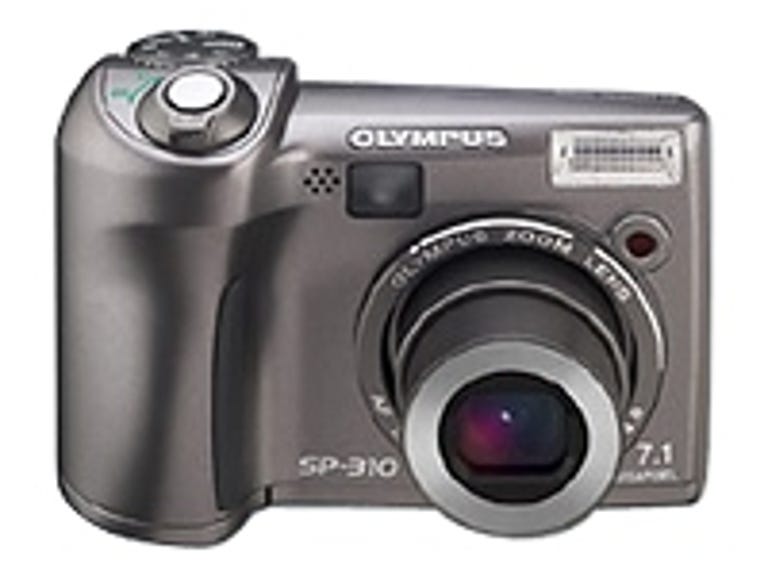With Olympus's 7-megapixel models, the SP-320 and the SP-310, the company caters to that snapshooter who wants a camera with more manual options than are offered by entry-level point-and-shoot models. The only difference between the two is the digital image stabilization available on the Olympus SP-320. That mode simply uses a higher ISO sensitivity setting in order to use a faster shutter speed; given the pair's poor high-ISO photo quality, you might as well opt for the Olympus SP-310 and save about $20. Furthermore, pitted against similarly priced models such as the Canon PowerShot A700 or the Fujifilm FinePix F30, both of which deliver better performance and photo quality, the good-but-not-great pair from Olympus don't fare terribly well.
Weighing just more than eight ounces with two AA batteries and an xD-Picture card installed, the Olympus SP-310/320 is too bulky to call a pocket camera, but it doesn't take up much room in a purse, and it'll ride just fine holstered to your belt in an optional carrying case. The 3X, 38mm-to-114mm zoom lens retracts when the power is turned off. Around back you'll find a sharp, 2.5-inch LCD for framing your shots and viewing them once they've been taken. If you want to conserve battery life--no rechargeables are included, though the camera will accept them--or find the LCD washing out in bright sunlight, you can frame your shot with the small optical viewfinder. Having that option is always a plus.
The Good
The Bad
The Bottom Line
The camera feels well balanced, and most of the controls are within easy reach of your thumb. A protruding grip lets you hold the camera steady with a single hand. The layout--with the mode dial on the top of the camera, as well as the menu systems and various button placements--will seem familiar to those who've previously owned an Olympus camera, but unless you shoot entirely in automatic mode, you'll have to poke around through the menus and consult the manual to find all the manual features and settings. On the upside, Olympus's excellent built-in help system actually tells you what a particular setting is for and how each of the options differs.
Although their specs and feature sets are pretty typical for its class, we were surprised to find that both the Olympus SP-310 and the Olympus SP-320 support uncompressed raw files--the unprocessed data directly off camera's sensor--for the best, most easily manipulated photo quality. Raw files are very large--20MB each--but you'll need to buy a high-capacity xD card to supplement the camera's 25MB of built-in memory anyway. In addition to its 25 scene modes, the SP-310/320 provides full auto, semimanual aperture- or shutter-priority, or completely manual shooting. You can choose from three different autofocus settings--completely auto, center-frame, and user-selectable area--plus a manual focus mode with a helpful magnifying reticule to assist in focusing through the LCD screen. Lastly, it offers the de rigueur 30fps VGA movie capture up to card capacity.
Overall, the SP-310/320's performance is mixed, significantly better in good light than dim. Elapsed time from power on to first shot is about 2.1 seconds, with 2 seconds between subsequent shots. Enabling the flash bumps that up to a still-respectable 3 seconds. Shutter lag is a bit higher than competing models: a passable 0.6 second under high-contrast conditions, but sluggish 1.5 seconds under low-contrast illumination. The camera can shoot continuously at 1.8fps at highest image quality and 5fps at lowest quality.
Photo quality is decent; if you don't compare it to that of other cameras, you could probably be pretty happy with it. Hues are accurate and white balance is neutral, but a lack of dynamic range in the highlights make photos look low-contrast with desaturated colors. JPEG images are soft--the raw versions unusably so, even after turning up the sharpening as far as possible--with details falling just shy of resolved. Focus falls off sharply on the left side, producing haloes on light edges. Photos shot at ISO 64 and ISO 100 have little noise, but at ISO 200, the SP-310/320's odd combination of noise suppression and aggressive sharpening yields a noticeable, mosaic-like grain that is visible on 8x10 prints. With the best cameras in this class, you can shoot as fast as ISO 400 before running into comparable artifacts. (The higher the ISO setting, the faster a shutter speed you can use, but unpleasant artifacts increase too.)
The Olympus SP-310 and the Olympus SP-320 are competent shooters and compact, feature-rich cameras that are nevertheless outclassed by competitors' speed and photo quality.
Seconds
(Shorter bars indicate better performance)
| Typical shot-to-shot time | Time to first shot | Shutter lag (typical) |
Frames per second
(Longer bars indicate better performance)

